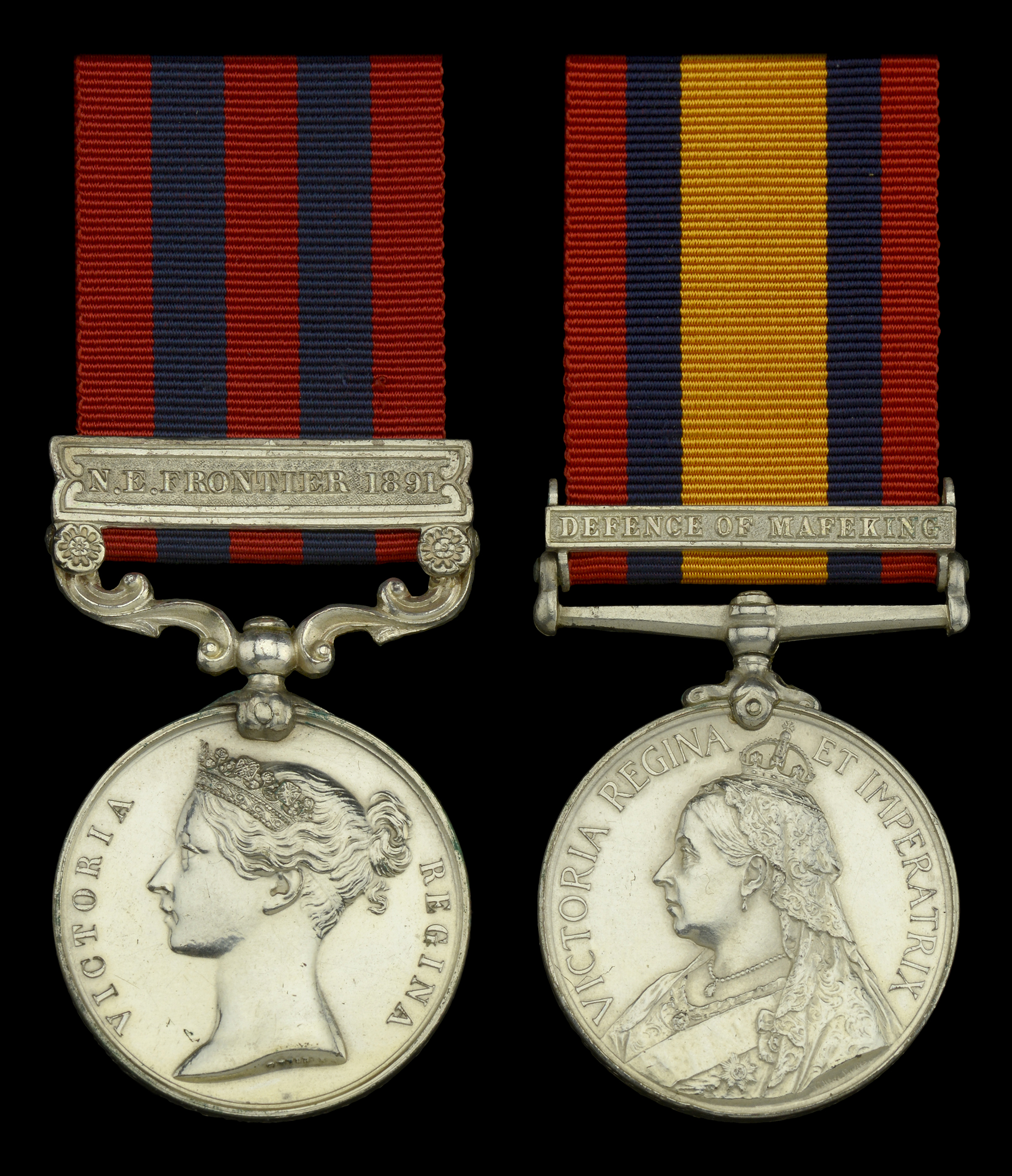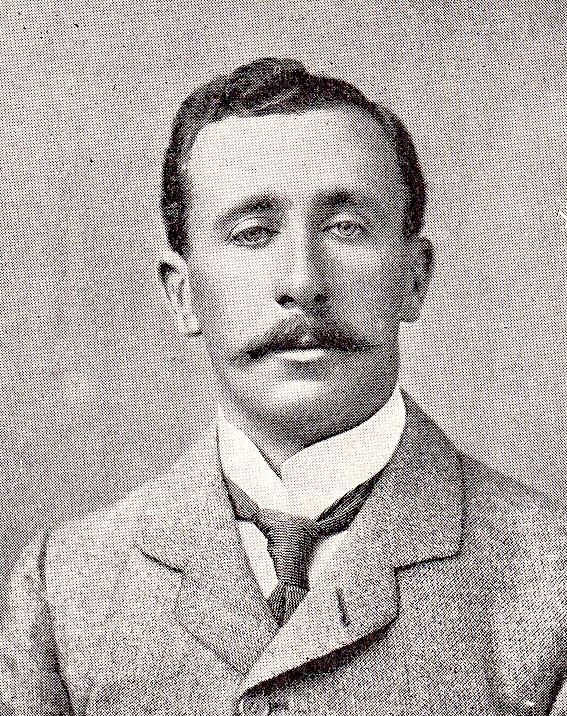The important campaign pair awarded to Captain R. J. Vernon, King’s Royal Rifle Corps and Protectorate Regiment, who was killed in action at Game Tree Fort, Mafeking, 26 December 1899 India General Service 1854-95, 1 clasp, N.E. Frontier 1891 (Lieutt. R. J. Vernon 4th Bn. K.R. Rif. C.); Queen’s South Africa 1899-1902, 1 clasp, Defence of Mafeking (Capt: R. J. Vernon, Protect: Rgt: F.F.) extremely fine (2) £5,000-£7,000 --- Ronald James Vernon was born on 25 January 1866, son of Sir Harry Vernon, of Hanbury Hall, Bromdgrove. He became a Second Lieutenant in the King's Royal Rifle Corps in January 1889, being promoted to the rank of lieutenant in 1891. He served in the N.E. frontier campaign of 1891, and qualified for the medal with clasp. He was appointed A.D.C. to the General Officer Commanding at the Cape of Good Hope, 1894-98. Promoted to Captain in 1897, he was appointed for special service in South Africa in July 1899 and attached to the Protectorate Regiment. He was present during the defence of Mafeking, and was killed in action during the attack on Game Tree Fort on the day after Christmas, 1899. Vernon was mentioned several times in the despatches sent by Major-General R. S. S. Baden-Powell to the Commander-in-Chief, where he stated that 'Captain Vernon, King's Royal Rifle Corps, was a most successful Officer in command of a squadron, and displayed the greatest gallantry in action. He was killed in action on 26th December.' Two actions in which Captain Vernon was involved were described in Baden-Powell's despatches: 'Surprise on Enemy's Western Laager, 7th November 1899. At 2.30 a.m., Major Godley paraded his force, in accordance with a plan I had arranged, to attack the western camp of the enemy with a heavy fire at daylight, and then to retire again before enemy's guns and reinforcements arrived on the scene. The force in enemy's camp was reckoned at 200 to 250. Our force consisted of two 7-prs; one 1-pr. Hotchkiss, under Major Panzera; one squadron of 60 men, Protectorate Regiment, dismounted, under Captain Vernon; one troop of men, Bechuanaland Rifles, mounted, under Captain Cowan. The forces moved out along the heights to about 1,500 yards in advance of Major Godley's position; Captain Vernon's squadron leading in attack order, with the guns on his left rear, and Bechuanaland Rifles covering his right rear. At 4.15 a.m., our guns opened on the enemy at 1,800 yards, and the squadron fired volleys by alternate troops into the enemy's camp, over which they had full command from the heights they were on.’ 'Action at Game Tree, 26th December 1899. The Boers' work at Game Tree, 2,500 yards north of town, had checked our grazing in that direction, and it commanded our line of communication northward. Some shells thrown into it a few days previously had caused enemy temporarily to vacate it, showing it to be a weak open work; this bad been confirmed by reconnaissance by our scouts, but as the enemy had been seen strengthening it during the past few days, I determined to attack before they should make it impregnable. Accordingly, two squadrons Protectorate Regiment, supported by armoured train and Bechuanaland Rifles, were ordered to attack from the left flank of the work, under direction of Major Godley, while three guns and Maxim prepared the way from the right front of the work. This scheme was carried out at dawn on the 26th, the guns making good practice, and the two squadrons advancing in attack formation exactly as required. But on pressing home the attack a heavy fire killed or wounded most of the Officers and the leading troops. These succeeded in gaining the parapet, but the work was found to have been strongly roofed in and so closed as to be impregnable.' The following account was published in Flag to Pretoria: 'Christmas went by peacefully; the garrison feasted; but for many on that day it was a case of "Let us eat and drink, for tomorrow we die," since Colonel Baden-Powell had determined to make a desperate attack on the 26th upon the Dutch position known as Game Tree Fort. ... Long before dawn the troops were in position. Two squadrons of the Protectorate Regiment were to attack from the east, under the command of Captains Vernon and Fitzclarence, supported by 300 men of the garrison with all the available artillery and the armoured train. As the first faint glimpse of breaking day showed over the veldt, at 4.15 a.m., the guns opened their fastest fire. The Boers immediately replied; a volley from the direction of the fort showed that they were upon the alert, and with a beavy boom the great 6-in. Creusot joined in the battle. In the dim, grey light the flashes of cannon and rifles flicked along the horizon like summer lightning. From Cannon Kopje, an outwork in the Mafeking defences, a 7-pounder did its feeble best to keep down the fire of the big gun. Major Panzera, who was in charge of the British artillery, was anxious to breach the walls of the fort, so as to render an assault easy. He fired steadily at the work, but from the manner in which it had been strengthened by the Boers, and from the inferior quality of his guns, could make little or no impression. A few shrapnel were burst just over the fort, and may have caused the enemy some loss; most of the projectiles, however, exploded against the sandbag face without result, without even battering down the rampart. Then about 5 a.m. the signal was given to the artillery to cease fire; the armoured train blew a deep blast on her whistle; the rifle fusillade of the two opponents blazed up furiously, and through a sheet of bullets the Protectorate Regiment advanced to the assault. The men dashed forward in swift rushes, keeping admirable order, their officers well in front, with such spirit and gallantry that all who saw were filled with admiration. A few fell, but the losses were not heavy at this stage, despite the bullets which seemed to come at once from every quarter. Half the distance had been covered, when the men, by order, lay down to recover breath, and, as they lay, opened fire with their rifles. Then the order "Fix bayonets" was given; the steel glinted in the rays of the early sun, and the sixty prone figures rose as if by clockwork from the ground and swept with a cheer towards the fort, now only 300 yards away. Captain Sandford was one of the first to fall in this rush; in an instant be was hit twice; one wound through the spine was mortal; but be died calling upon his men to go forward, with his face to the foe. And now the Boer fire blazed up with a fury and intensity that appalled the onlookers. The fort vomited bullets in sheets from every loop-hole. Yet the Protectorates did not halt or check for a moment. Captain Fitzclarence was down with a bullet through his thigh; Captain Vernon was wounded also, but he was still in front, refusing to go to the rear. The men were worthy of these officers. As they closed in on the fort they sent up cheer after cheer, and the spectators, from the note of triumph which rang in their shouts, were certain that victory was as good as won. But the cry of triumph was, after all, only that of men who stand in the presence of death with the consciousness that they have done supremely well. For the last 25 yards of the rush, every man in that little band of heroes had seen that success was not to be dreamt of, and that only one thing remained - to die with honour. From a deep ditch there rose before them a perpendicular rampart, with row upon row of loop boles; and even if the rampart were climbed the work was roofed in with iron, so that access would still be difficult. Yet the wounded Captain Vernon, Lieutenant Paton, Corporal Cooke, Corporal Pickard, and Sergeant Ross, broke desperately forward, crossed the ditch, and strove to reach the loop-holes, into which the officers emptied the...









